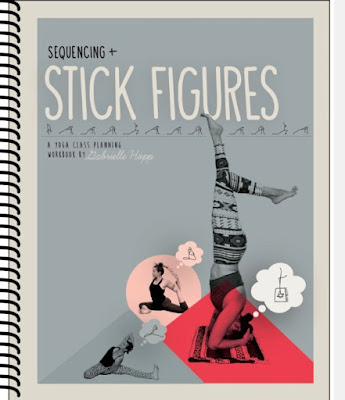Greetings Yogis!
This is the last post!
Why, you ask?
Because of something really exciting!
I am pleased to announce a new website + blog and a new totally awesome project that I've been working on.
For the past 11 months I've been working in conjunction with a graphic artist on a Yoga Sequencing manual.
When it started, it was simply a "How to Draw Stick Figures for Yoga" book. It was kind of a good idea, but mostly just a fun project for me to work on. And someone told me that it wasn't a good idea, so then I definitely thought I should do it.
Anna Oyer (who's an amazing graphic designer + yogi) did all the layout + editing. She also became a great fountain of ideas which helped grow the scope of the book to be broader and more effective. I don't think I can properly express my gratitude toward her + her amazing work. But let it be known that this project is WAY AWESOMER because of Anna.
For instance, when I started, it was all hand-drawn and I made it Microsoft Word Project Layout, like a true professional.
Here's how it looked------------------------->>>
Here it is now--------------------->>>
Isn't it awesome?
And here are just a few things that it covers:
How to understand body orientation in yoga asanas
How to draw over 60 poses with variations and props
Skillful sequencing ideas which will lead to meaningful and engaging classes
How to create full class-plans with stick figures and intelligent sequences
Understanding a peak-pose approach and how to get your students there
----------------------------------------------------------------------
So, that's the project part. I literally could not be more proud of it.
Additionally, as I mentioned before, I also have a new website + blog.
My friend Allyson Gibbs designed the site and I have to say that it's pretty swell.
Here is a link: http://www.gabriellehoppyoga.com/
The website will include links to my class-schedule and workshops at One Tree Yoga, a link to purchase my new book + a new platform for this blog. Future posts will link directly to the site, heading right to them as before.
Adios for now, friends. Stay tuned for the book's release (in the next two weeks, or so!) and I'll see you on the new site in the near future!
This is the last post!
Why, you ask?
Because of something really exciting!
I am pleased to announce a new website + blog and a new totally awesome project that I've been working on.
 |
| Before! |
When it started, it was simply a "How to Draw Stick Figures for Yoga" book. It was kind of a good idea, but mostly just a fun project for me to work on. And someone told me that it wasn't a good idea, so then I definitely thought I should do it.
Anna Oyer (who's an amazing graphic designer + yogi) did all the layout + editing. She also became a great fountain of ideas which helped grow the scope of the book to be broader and more effective. I don't think I can properly express my gratitude toward her + her amazing work. But let it be known that this project is WAY AWESOMER because of Anna.
For instance, when I started, it was all hand-drawn and I made it Microsoft Word Project Layout, like a true professional.
Here's how it looked------------------------->>>
 |
| After! |
Now, I'm not saying it wasn't quite charming, but certainly not a high-quality book.
Plus it was very limited in its appeal. It was basically for teachers of yoga who wanted to class plan with stick figures.
It's still that, but now it's so much more. Anna came in and whipped it into shape, so now it looks more like <<<--------------- this
 |
| The Cover! |
Here it is now--------------------->>>
Isn't it awesome?
And here are just a few things that it covers:
How to draw stick figures in yoga poses
How to incorporate props into your drawings and classesHow to understand body orientation in yoga asanas
How to draw over 60 poses with variations and props
Skillful sequencing ideas which will lead to meaningful and engaging classes
How to create full class-plans with stick figures and intelligent sequences
Understanding a peak-pose approach and how to get your students there
----------------------------------------------------------------------
So, that's the project part. I literally could not be more proud of it.
Additionally, as I mentioned before, I also have a new website + blog.
My friend Allyson Gibbs designed the site and I have to say that it's pretty swell.
Here is a link: http://www.gabriellehoppyoga.com/
The website will include links to my class-schedule and workshops at One Tree Yoga, a link to purchase my new book + a new platform for this blog. Future posts will link directly to the site, heading right to them as before.
Adios for now, friends. Stay tuned for the book's release (in the next two weeks, or so!) and I'll see you on the new site in the near future!















